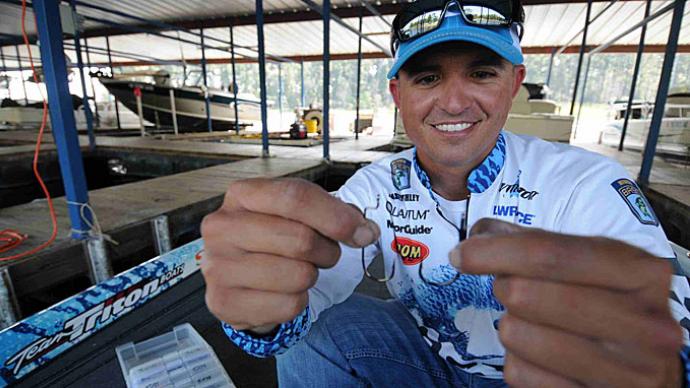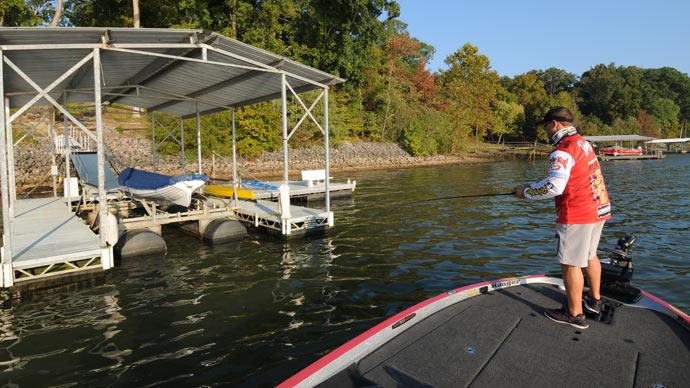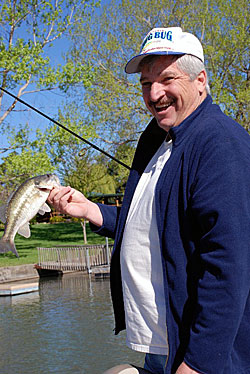
A carpenter has more than one saw or hammer to do his job. So a fisherman needs more than one hook to catch bass. In recent years, all sorts of specialized hooks have come out to match every fishing situation a bass angler could be confronted with. Do we need them all? No. But there are a handful of essential hooks that every bass angler needs to have in his tackle box.
Gerry Gostenik of Great Lakes Bass Fishing spends more time on the water in one summer than many anglers will spend in a lifetime. It’s the price of being successful and good at what you do. Gostenik has a pretty good idea of what works and doesn’t work for bass, having cut his teeth fishing tournaments all over the country and refining those techniques across the Great Lakes.
He said he didn't play favorites when I asked him about must-have hooks for bass fishing. “I don‘t have a hook sponsor,” he said. “So I don’t have any one company that I promote. I’m just telling you what works for me.”
Like many serious bass anglers, Gostenik is a big fan of Gamakatsu’s EWG Superline hook. Gamakatsu's Superline Offset Shank EWG Worm Hook is a “high carbon heavy-wire hook designed to fish braided line in heavy cover,” according to the manufacturer, that’s built for serious flipping in the clusters, overhead mats, or pads. But open-water bass anglers like Gostenik find that the hook excels when using soft plastics, jerkbaits, and Senkos with fluorocarbon. This super-strong hook doesn’t flex on the hook set. Gostenik said that a 3/0 size is about right for most of his fishing situations.
One reason smallmouth anglers love Gamakatsu's Superline Offset Shank EWG is that it’s the perfect choice when you require a quicker fall without adding weight. Want an immediate response to a falling Senko? Substitute a Superline EWG for a quicker descent that triggers bites.
Lake St. Clair endures a prolific mayfly hatch in June and July when the bass gorge on bugs. Gostenik said he resorts to pouring his jigs to use with grubs and subtle swim baits to imitate the Hexagenia and Ephemerella mayflies. “The hook I use is a Mustad light wire, long shank, needle point number 32724 NP-BN in a 5/0.”
“Kevin (as in Kevin VanDam) gave me a bunch of these Mustad hooks a few years ago. I’ve been using this particular model ever since. I make them with a couple of different heads using a Do-It mold. It’s all you need for about three weeks when the bass are gorging on the bugs.”
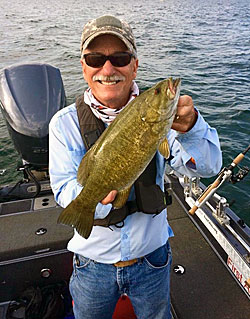
The hook is designed to fit a Do-It BBJ-3-AY mold. It features a 60-degree eye tie, 28-degree bend, the classic Mustad Ultra Point, and a black nickel finish.
Once the bug binge is over, smallies go deep, and it’s time for drop-shotting the rest of the summer into the fall. “I use the Owner Mosquito Hook in 1/0 100 percent of the time when I’m drop-shotting,” Gostenik said.
Designed for light line use, the Mosquito Hook is self-setting and is the ideal hook for windy conditions or turbulent water where it is challenging to keep a tight line. The hook excels for nose-hooking soft plastics and wacky worms. The Mosquito Hook features a black chrome finish and a fine-wire forged shank with an offset Super Needle Point. Gostenik said that he’s particularly fond of the Super Needle Point. “Too fine of a point, and it tends to bend or roll,” he said. Pro Packs are available in black chrome only.
Every bass angler needs a suitable replacement treble for stickbaits and crankbaits. “I use the Mustad UltraPoint KVD Elite Triple Grip Treble Hook when it comes to trebles,” he said. “I replace the hooks on all the crankbaits and stick baits that I get right out of the box.” He said he uses sizes 2, 4, and 6 depending on the bait.
The unique KVD shape combines hooking capability with exceptional holding properties. A modified, wider point angle creates a wider gap than like-sized round bend treble hooks. Because they use UltraPoint Technology, Mustad claims the KVD Elite Triple GripÒ Treble Hooks are 20% sharper and designed to stay sharper longer. Available in a black nickel finish, the hook features an Opti-Angle needlepoint, a standard length shank, and a ringed eye.
Sam Heckman is a regular on the Bass Federation tournament trail and has qualified for the championship on several occasions and cashed a check several times. Heckman firmly believes that Eagle Claw Hooks has had much to do with his success.
A Colorado native, Heckman joked, “When it comes to the absolute best hook on the market, there is only one...the sharpest hook in the world made right here in Denver, Colorado.”
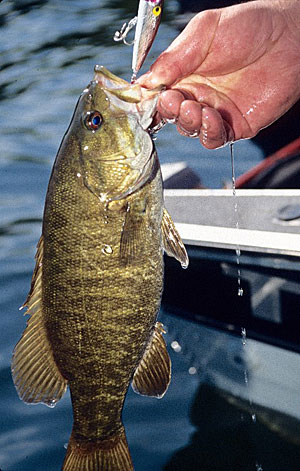
“I use the Trokar TK130 Flippin’ Hook a good deal of the time,” Heckman said. “It has a surgically sharpened point that is sticky sharp, heavy wire, has a welded eye, an extra-wide gap, and a forged straight shank. You’ll find me using that hook when throwing a Hula Grub or Zoom Super Speed Craw in nasty stuff when the sun is high. 4/0 or 5/0 are my favorite sizes. The other hook I use for grubs and craws is the Trokar TK 105 Big Nasty.”
Fishing Senkos or wacky-rigged baits requires a specialized hook. “My favorite when using Senkos is the Trokar TK97W. It’s weedless with a wide gap, up eye, and heavy wire, so I can throw it about anywhere. My favorite size is 2/0.”
“When it comes to hooks for worms, I prefer a couple of hooks depending on the situation,” he said. “The TK 105 Big Nasty is thicker than the original Lazer Trokar worm hooks. It has a very pronounced bend which helps improve hook-up ratios and stay on once they’re hooked.
“I find the 3/0 size covers most of my applications with this hook. If I’m looking for a lighter wire, finesse worm hook, I’ll use a 1/0 TK 110 or a TK180 light wire hook for open water, ledges, and around drop-offs and a little beefier TK 120 when fishing around heavy cover.
“I like to tie my hook direct when I’m drop-shotting, so I choose the TK 150 drop shot hook in size 1. You need a super sharp hook when drop shotting because you’re using light line. Trokar’s patented hook sharpening technology does not need strong hook sets. For guys that like an inline hook when drop shotting, the TK 230 Helix Drop Shot Hook is the answer. It eliminates line twists.”
Tournament angler Scott Dobson agrees with Gostenik that the Gamakatsu’s EWG Superline Hook is a great piece of metal that finds its way to the end of his line with uncanny frequency. This hook uses heavier gauge steel wire that will not straighten out under load, but with enough flex that it is not brittle and will not break when stressed. The only place the two disagree is on size. Dobson prefers a 5/0 for the majority of his fishing. It’s his favorite when fishing flukes, Senkos, and Texas-rigged baits.
Drop-shotting is a large percentage of the time Dobson spends fishing on the Great Lakes. “The Gamakatsu Drop/Split Shot Hook is a favorite for drop-shotting,” he said. “I’ve caught thousands upon thousands of smallmouths on it, and it never fails or bends over. They feature ultra-sharp points that will stick to anything that touches them and a bend behind the point that will hold a nose-hooked worm in the perfect position ninety degrees from the line.” Dobson said that the 1/0 size is his most commonly used hook.
“One of my go-to hooks for flippin’ is the BMF from Reaction Innovations,” said Dobson. “It’s my standard worm hook with a welded eye that prevents the braid from slipping into the slot between the eye. With a lot of hooks, bass will pull the eye open. Not his one. I use the 3/0 for the Smallie Beaver and the 4/0 for the Sweet Beavers.” These hooks may be challenging to find, though.
“Tubes are still very effective on the Great Lakes even though they’ve been around a long time,” advised Dobson. “With tubes, I use strictly the jigs made by Provider Tackle. They’re made on an Owner hook 90° Jig Hook that features a 90° eye-bend, short shank, curved in point, and a corrosion-resistant black chrome finish.” The weight on the Provider jigs is distributed evenly on the hook to balance the tube and allow for a vertical fall that forces the nose down for life-like movement. When rigged properly, the bait will have a streamlined swimming action on the retrieve, which helps reduce line twists and makes the bait look like natural forage.
Dobson uses a size 2/0 tube hook, which is traditionally smaller than most anglers use. The smaller hook provides a more natural profile and fewer snags. “If it ain’t broke, don’t fix it!” joked Dobson.
Dobson said it’s pretty hard to beat the Gamakatsu Magic Eye for a replacement treble. The Magic Eye has a tapered flat portion that easily fits between the split ring wires to make upgrading your hooks must easier and faster. The Magic Eye also features Gamakatsu’s ultra-sharp points and strong construction. Dobson said that a size four treble meets most of his hook replacement needs regarding trebles.
Dobson said that his secret weapon when it comes to hooks is an Arkansas wet stone. “It’s worth its weight in gold,” he said.
BassResource may receive a portion of revenues if you make a purchase using a link above.



